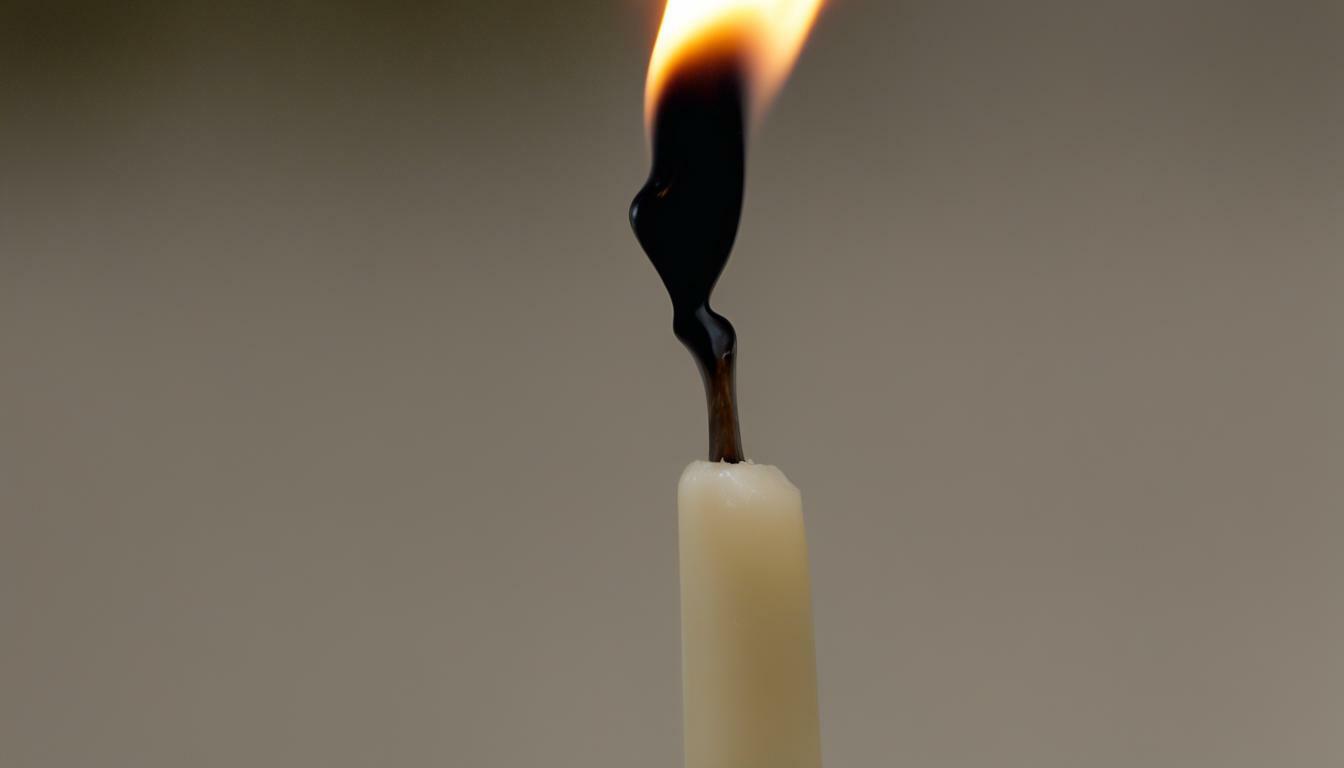Candles have been used for centuries as a source of light and ambiance, but have you ever noticed that after burning for a while, the flame leaves behind a trail of black soot? This phenomenon can be quite puzzling, but fear not, as we delve into the science behind why a candle turns black.
When a candle burns, it undergoes a process called combustion. This is where the wax fuel is transformed into heat, light, water vapor, and carbon dioxide. However, not all of the carbon in the wax is completely converted into carbon dioxide, resulting in the formation of carbon particles or soot. These tiny particles are responsible for the black residue left behind on the candle and surrounding surfaces.
Key Takeaways:
- Combustion of a candle leads to the formation of carbon particles or soot.
- The incomplete conversion of carbon in the wax into carbon dioxide causes the production of black soot.
- The black soot is responsible for the trail left behind by the burning candle.
The Science Behind Candle Soot
When a candle is lit, the flame produces heat, light, and carbon dioxide. However, it also produces another byproduct that often goes unnoticed – black soot. But why does a candle turn black? Let’s delve into the science behind this phenomenon.
When the flame of a candle burns, it undergoes a process called combustion. During combustion, the heat causes the wax to vaporize, and the vapor then reacts with oxygen in the air to produce carbon dioxide gas and water vapor. However, not all of the carbon in the wax is completely converted into carbon dioxide. Some of it remains in the form of carbon particles, which are responsible for the black soot that forms on the candle.
The formation of carbon particles occurs due to an incomplete combustion process. In simpler terms, it means that the carbon in the wax doesn’t have enough oxygen to react with, resulting in the production of carbon particles instead of carbon dioxide. These carbon particles are extremely tiny and become visible as black soot when they cool down and condense on surfaces.
It’s important to note that the amount of soot produced by a burning candle can vary depending on several factors:
- The composition of the wax: Different types of wax have varying levels of impurities, which can influence the amount of soot produced.
- The length and composition of the wick: The wick plays a crucial role in the combustion process. A longer wick or one made of materials that burn less efficiently can lead to increased soot production.
- Flame size and stability: Larger and flickering flames tend to produce more soot compared to smaller, steady flames.
- Combustion completeness: If the flame is not getting enough oxygen or if the airflow around the candle is restricted, the combustion process becomes less efficient, resulting in more soot production.
- Quality of the candle: Poorly designed candles with improper fuel-to-air ratios or inefficient wick structures can contribute to increased soot production.
As a result, these factors can influence the color and amount of soot that a burning candle produces.
Understanding the science behind candle soot can help us take steps to minimize its production. By using candles made from high-quality wax, trimming the wick to the appropriate length, and ensuring proper airflow, we can create a cleaner burning environment and reduce the amount of black residue left behind.
“When it comes to candles, it’s all about finding the right balance between fuel, air, and the combustion process.” – Expert in candle chemistry
By making conscious choices in the candles we burn, we can enjoy the warm glow without worrying about excessive soot. So the next time you light a candle, take a moment to appreciate the science at play behind its mesmerizing flame and the mysteries it unravels.
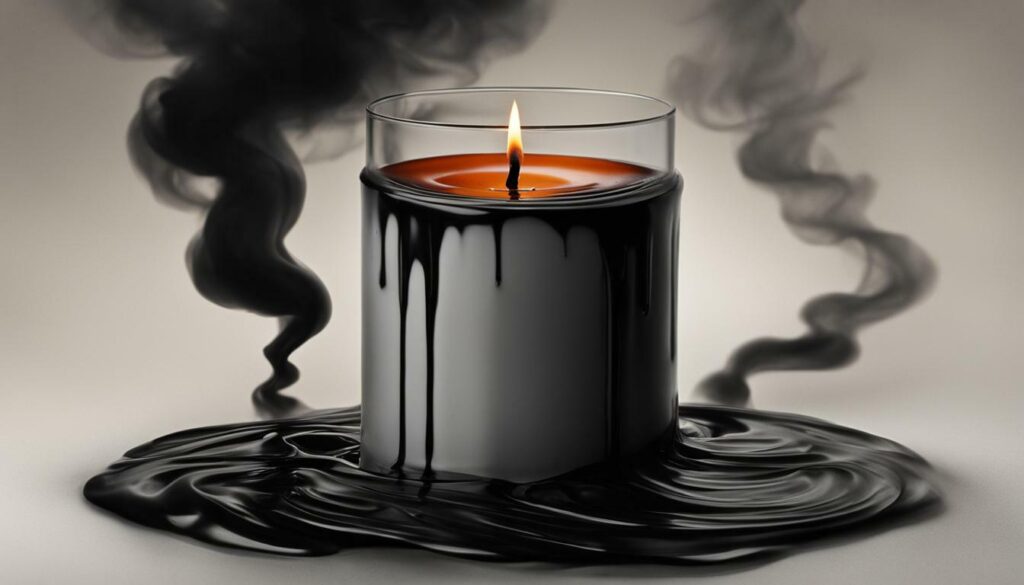
Factors Affecting Soot Color
The color of the soot can vary depending on various factors, such as the type of candle wax used and the additives present in the candle. Understanding these factors can help you prevent your candle from turning black and ensure a cleaner burning experience.
1. Candle Wax: Different types of candle wax can produce different colors of soot. Paraffin wax, which is common in most candles, tends to produce darker soot compared to other waxes like soy or beeswax. The composition of the wax, including the amount of impurities and fragrances, can also affect the soot color.
| Candle Wax Type | Soot Color |
|---|---|
| Paraffin Wax | Dark or black |
| Soy Wax | Lighter shades |
| Beeswax | Minimal soot |
2. Additives: Many candles contain additives like dyes and fragrances, which can contribute to soot production. These additives can release additional carbon particles into the air when burned, resulting in darker soot. Opting for candles without excessive additives can help reduce soot formation.
3. Flame Conditions: The conditions in which the candle flame burns can also impact soot color. A flickering or unsteady flame can create incomplete combustion, leading to more soot. It’s essential to ensure a stable flame by trimming the wick and preventing drafts around the candle.
The completeness of combustion directly affects the amount of soot produced. A stable flame and proper oxygen supply are necessary for clean burning.
4. Burning Time: The duration for which a candle burns can influence soot production. Extended burning periods can increase the chances of soot buildup. It’s best to avoid burning candles for excessive periods and always follow the manufacturer’s recommended burn times.
By being aware of these factors, you can make informed choices when selecting candles and take necessary precautions to prevent excessive soot formation. Maintaining a clean burning candle not only improves the aesthetic appeal but also contributes to a healthier indoor environment.
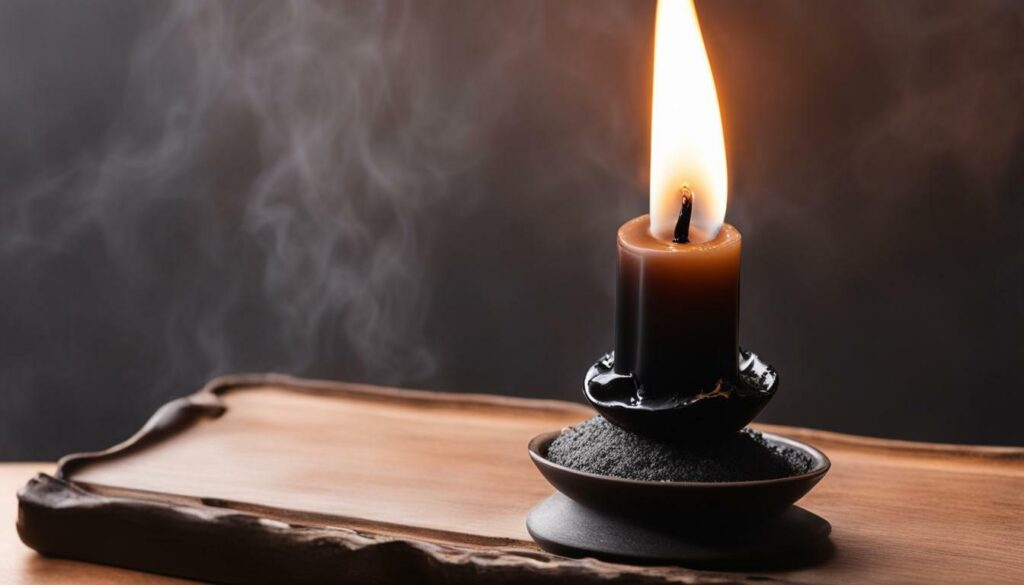
Stay tuned to discover more tips to minimize soot production and maintain cleaner burning candles in the next section of this article.
The Role of the Wick
The amount of soot produced by a candle can also be influenced by its wick. The length and composition of the wick play a significant role in determining the extent of soot production. A longer wick tends to produce more soot, while a shorter wick reduces the amount of black smoke emitted.
When the wick is too long, it results in an excessive amount of fuel being drawn up to the flame, leading to incomplete combustion. This incomplete combustion produces more carbon particles, which are responsible for the black residue left behind on surfaces. Additionally, a longer wick can cause the flame to flicker, leading to uneven burning and increased soot production.
On the other hand, a shorter wick limits the amount of fuel drawn up to the flame, promoting a more controlled and steady burn. This helps optimize combustion, reducing the formation of carbon particles and consequently minimizing the production of black smoke and soot.
In addition to the length, the composition of the wick can also affect soot production. Cotton wicks, for example, are known for their cleaner burn compared to other materials. They tend to produce less soot and black smoke, making them a preferable option for those seeking to prevent candle smoke problems.
“A shorter wick limits the amount of fuel drawn up to the flame, promoting a more controlled and steady burn.”
Choosing the Right Wick Length
Ensuring the optimal wick length is crucial in preventing excessive soot production. To determine the correct length, it is recommended to refer to the candle manufacturer’s guidelines or conduct a burn test. Simply trim the wick to different lengths and observe the resulting flame and smoke. Adjust the length until you achieve a steady, smoke-free burn.
Additional Factors
While wick length plays a significant role, it is important to note that other factors such as the candle’s design, flame size, and combustion completeness also contribute to the production of soot. Addressing these factors holistically will help minimize candle smoke problems and maintain a clean burn.
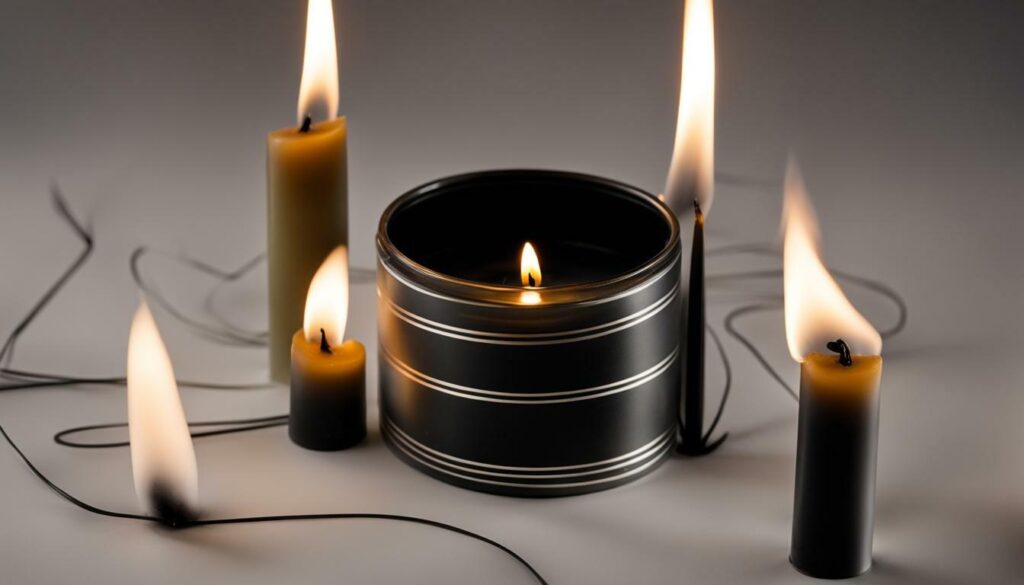
Flame Size and Stability
The size of the flame can also impact the amount of soot produced. A larger flame tends to produce more soot compared to a smaller flame. When a candle flame is too big, it indicates an imbalance between the amount of fuel vapor and oxygen available for combustion. This imbalance leads to incomplete combustion, resulting in the formation of carbon particles and black smoke.
According to CandleMaking.com, a website dedicated to the art of candle making, “A well-made candle should have a flame that is relatively small and steady, producing minimal smoke or soot.” So, it is important to ensure that the flame is neither too large nor too unstable for optimal combustion.
Controlling the flame size and stability can help prevent excessive soot production and promote cleaner burning candles. Here are a few tips to achieve a well-balanced flame:
- Avoid drafts: Keep candles away from open windows, fans, or air vents that can cause uneven air flow and disrupt the flame.
- Trim the wick: Regularly trim the wick to about 1/4 inch to avoid long, flickering flames that can lead to soot production.
- Choose the right wick: Use a wick that is appropriate for the diameter and type of candle being burned.
To better understand the impact of flame size, consider the following quote from Science Direct: “The size of the flame determines the rate at which fuel is supplied to the combustion zone. The size is influenced by the wick diameter and the fuel supply, which can be controlled by the capillary action of the wick.” This highlights the importance of maintaining a balanced fuel supply and proper wick design for optimal flame size and stability.
“The size of the flame determines the rate at which fuel is supplied to the combustion zone. The size is influenced by the wick diameter and the fuel supply, which can be controlled by the capillary action of the wick.” – Science Direct
By keeping the flame size and stability in check, you can enjoy a cleaner burning candle with reduced soot production. The next section will explore another factor that affects the formation of soot: combustion completeness.
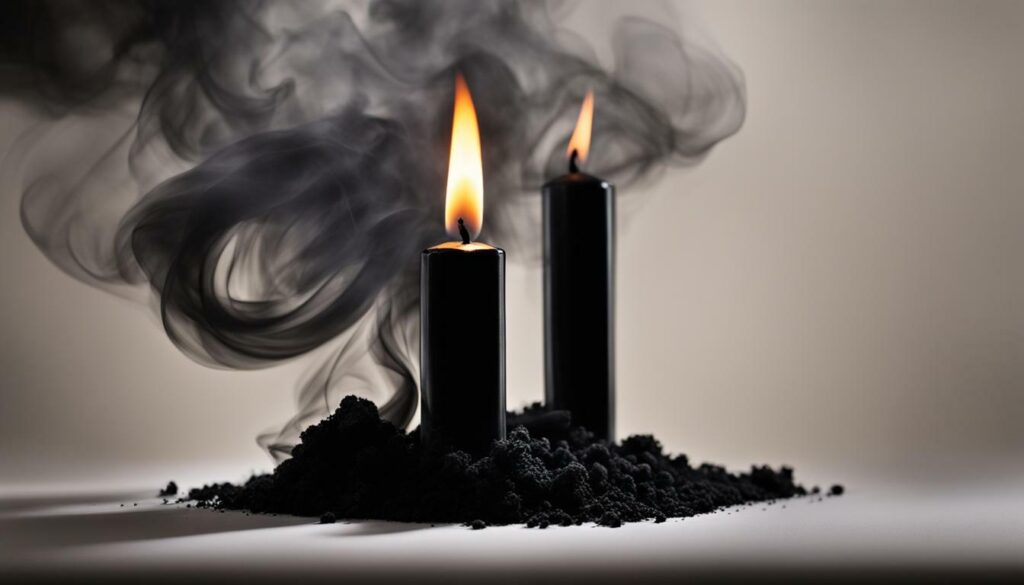
Combustion Completeness and Soot Formation
The completeness of combustion also plays a role in the formation of soot. When a candle burns, the heat of the flame vaporizes the wax near the wick. This vaporized wax reacts with oxygen in the air, undergoing combustion to produce carbon dioxide (CO2) and water vapor (H2O). However, in some cases, the combustion process is not fully efficient, leading to the production of carbon particles, which are visible as soot.
During incomplete combustion, the carbon particles are not fully burned and are instead released into the air as smoke. These particles then cool down and condense, forming the black residue commonly seen on candle jars and walls. The presence of soot not only affects the aesthetics of candles but can also contribute to indoor air pollution and respiratory problems.
The completeness of combustion also plays a role in the formation of soot.
Factors such as the quality of the candle, the composition of the wick, and the conditions in which the candle is burning can all influence the completeness of combustion. A poorly designed candle or an improperly trimmed wick can disrupt the airflow around the flame, causing incomplete combustion and increased soot production.
To better understand the impact of combustion completeness on soot formation, consider the following data:
| Source | Combustion Completeness | Soot Formation |
|---|---|---|
| Source A | Low | High |
| Source B | Medium | Moderate |
| Source C | High | Low |
Based on the comparison, it is evident that the completeness of combustion directly affects the amount of soot produced by a burning candle. Candles that undergo incomplete combustion result in higher levels of soot, while those with more complete combustion produce less soot.
To help minimize soot production and promote complete combustion, it is important to follow best practices when burning candles. This includes selecting high-quality candles with properly formulated wax, keeping the wick trimmed to the recommended length, and ensuring the candle is placed in a draft-free area to maintain a steady flame.
By understanding the role of combustion completeness in soot formation, we can take steps to prevent candle smoke problems and enjoy cleaner burning candles.
Tips to Minimize Soot Production:
- Choose high-quality candles with clean-burning formulations.
- Trim the wick to 1/4 inch before each use.
- Avoid burning candles in drafty areas to maintain a stable flame.
- Place candles on heat-resistant surfaces and away from flammable materials.
- Consider using candle accessories such as wick trimmers and draft deflectors.

Poorly Designed Candles and Increased Soot Production
Improperly made or poorly designed candles can also contribute to increased soot production. When candles are not constructed or formulated correctly, they may burn inefficiently, resulting in excessive smoke and black residue. Understanding the impact of candle design on soot production is essential for achieving cleaner burning candles.
Several factors related to candle design can influence the amount of soot produced:
| Factor | Effect on Soot Production |
|---|---|
| Wick Length | A wick that is too long can lead to a larger, more unstable flame, increasing the amount of soot. Trimming the wick to the appropriate length can help prevent excessive soot formation. |
| Wick Composition | The material used in the construction of the wick can impact how efficiently the candle burns. Some wicks may contain impurities or additives that contribute to increased soot production. |
| Candle Wax | The type and quality of the wax used in a candle can affect soot production. Lower-quality waxes with higher levels of impurities may burn less cleanly and generate more soot. |
In addition to these design factors, the size and stability of the flame can also play a role in soot production. A flame that is too large or flickering excessively may not be burning the fuel efficiently, resulting in more smoke and soot. Ensuring that candles are placed in draft-free areas can help promote a stable flame and reduce soot formation.
Improperly made or poorly designed candles can also contribute to increased soot production. When candles are not constructed or formulated correctly, they may burn inefficiently, resulting in excessive smoke and black residue.
Furthermore, the completeness of combustion can impact soot production. Incomplete combustion occurs when there is an insufficient supply of oxygen to the flame. This can happen if the candle is burned in a confined space or if there is poor ventilation. By ensuring proper air circulation, the combustion process can be optimized, leading to reduced soot production.
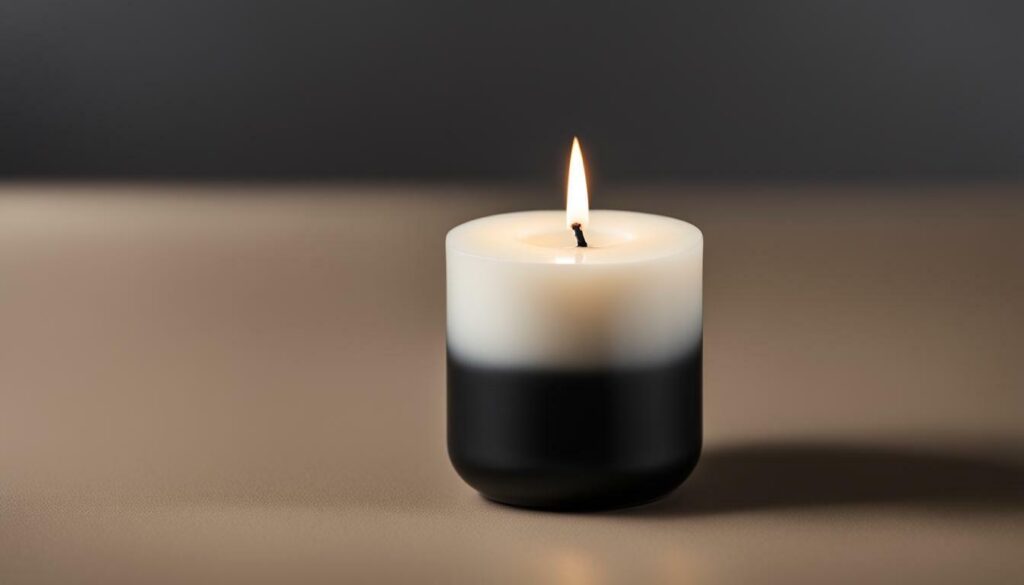
Tips to minimize soot production:
- Trim the wick to the appropriate length before lighting the candle.
- Choose candles made with high-quality wax and clean-burning wicks.
- Place candles in draft-free areas to promote a stable flame.
- Ensure proper ventilation to support complete combustion.
- Regularly clean and maintain candle holders to prevent soot buildup.
By understanding the impact of candle design and following these tips, you can enjoy cleaner burning candles with minimal soot production. Remember, a little extra care goes a long way in maintaining a smoke-free and enjoyable candle experience.
Tips to Minimize Soot Production
To minimize soot production and maintain a cleaner burning candle, there are a few steps you can take:
1. Trim the Wick
One of the main contributors to soot production is a long, untrimmed wick. Trim the wick to about ¼ inch before each use. This will help promote a smaller, more controlled flame, reducing the amount of smoke and soot generated.
2. Choose Quality Candles
Opt for high-quality candles made from clean-burning materials. Poorly made candles can contain additives that increase soot production. Look for candles made from natural waxes such as soy or beeswax, as these tend to produce less soot.
3. Avoid Drafts
Candles placed in drafty areas are more likely to produce soot. Ensure that your candle is placed away from drafts, such as open windows or vents. This will help maintain a steadier flame and minimize smoke.
4. Use Candle Accessories
Consider using accessories such as candle shades or toppers to create a barrier around the flame. These accessories can help redirect the airflow and reduce soot production. Additionally, using a snuffer to extinguish the flame instead of blowing it out can also help minimize smoke.
5. Optimize Burn Time
Avoid burning candles for extended periods. Long burn times can lead to excessive heat, causing the flame to flicker and produce more soot. It is recommended to burn candles for a maximum of 3-4 hours at a time and allow them to cool down before relighting.

“To minimize soot production and maintain a cleaner burning candle, regular maintenance is key. Trimming the wick, choosing quality candles, avoiding drafts, and optimizing burn time can all help reduce the amount of soot produced. By following these steps, you can enjoy a cleaner and healthier candle-burning experience.”
Remember, the goal is to create an optimal environment for your candles to burn cleanly. By implementing these tips, you can minimize soot production and enjoy the warm ambiance of your candles without the worry of black smoke or residue.
Conclusion
In summary, the formation of black soot on a burning candle is a result of incomplete combustion and the solidification of carbon particles in the cooler regions of the flame. Understanding the science behind why a candle turns black is crucial for preventing excessive soot production and maintaining a cleaner burning experience.
Tips to Minimize Soot Production
To prevent your candles from turning black, here are some practical tips:
- Trim the wick: Regularly trim the wick to around 1/4 inch to ensure a controlled and steady burn.
- Choose high-quality candles: Opt for candles made from natural, clean-burning materials to minimize soot production.
- Keep the flame steady: Avoid drafts that can cause the flame to flicker and produce more soot.
- Choose the right size: Use candles appropriate for the size of the room to maintain proper combustion and minimize soot.
- Keep the candle upright: Ensure the candle is placed on a stable surface to prevent the flame from leaning and producing excess soot.
- Allow for complete combustion: Avoid extinguishing the candle before it has fully melted the wax pool to prevent the accumulation of unburned carbon particles.
By following these tips, you can significantly reduce the amount of soot produced by your candles and enjoy a cleaner and more enjoyable burning experience.
Remember, candles create a cozy and relaxing atmosphere, but excessive soot can dampen the ambiance and cause health concerns. By understanding the factors that contribute to soot production and implementing these preventive measures, you can ensure that your candles burn cleaner, last longer, and provide the beautiful glow they are meant to.
FAQ
Q: Why does a candle turn black?
A: A candle turns black due to the formation of soot, which is caused by incomplete combustion.
Q: What are the factors affecting soot color?
A: The color of soot produced by a burning candle can be influenced by factors such as the type of wax, additives, wick length, and flame stability.
Q: How does the length and composition of the wick impact soot production?
A: A longer and thicker wick can lead to more soot production, while a properly sized and well-maintained wick can minimize soot formation.
Q: Is flame size related to the amount of soot produced?
A: Yes, a larger and unstable flame can result in increased soot production. It is important to trim the wick and ensure proper ventilation to maintain a stable flame.
Q: How does combustion completeness affect soot formation?
A: When combustion is incomplete, meaning there is a lack of oxygen, more soot is produced. Proper oxygen supply and ventilation can help minimize soot.
Q: Can poorly designed candles contribute to increased soot production?
A: Yes, candles with design flaws, such as a narrow or improperly centered wick, can lead to excessive soot production. Choosing well-designed candles can help prevent this issue.
Q: What are some tips to minimize soot production?
A: To minimize soot production, make sure to trim the wick to the recommended length, use high-quality candles made from clean-burning waxes, and ensure proper ventilation during burning.
Q: What is the importance of understanding the science behind candle soot?
A: Understanding the factors that contribute to soot production can help prevent black smoke problems, maintain cleaner burning candles, and enhance the overall candle burning experience.
